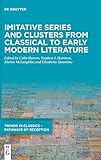Imitative Series and Clusters from Classical to Early Modern Literature / ed. by Colin Burrow, Stephen J. Harrison, Martin McLaughlin, Elisabetta Tarantino.
Material type: TextSeries: Trends in Classics – Pathways of Reception ; 4Publisher: Berlin ; Boston : De Gruyter, [2020]Copyright date: ©2020Description: 1 online resource (XIII, 358 p.)Content type:
TextSeries: Trends in Classics – Pathways of Reception ; 4Publisher: Berlin ; Boston : De Gruyter, [2020]Copyright date: ©2020Description: 1 online resource (XIII, 358 p.)Content type: - 9783110699500
- 9783110699692
- 9783110699593
- online - DeGruyter
- Issued also in print.
| Item type | Current library | Call number | URL | Status | Notes | Barcode | |
|---|---|---|---|---|---|---|---|
 eBook
eBook
|
Biblioteca "Angelicum" Pont. Univ. S.Tommaso d'Aquino Nuvola online | online - DeGruyter (Browse shelf(Opens below)) | Online access | Not for loan (Accesso limitato) | Accesso per gli utenti autorizzati / Access for authorized users | (dgr)9783110699593 |
Frontmatter -- Contents -- Acknowledgements -- List of Figures -- List of Tables -- Bibliographical Note -- Introduction: Seeing Through Texts -- Serial Similes in the Battle-Narrative of Virgil’s Aeneid -- The Constant Helmsman: Acoetes, Palinurus, and the Homeric Hymn to Dionysus -- Fisher of Men: A New Reading of Ausonius’ Catalogue of Fish -- The Works of the Sea: Mapping the Itineraries of Imitation in Late Antique Epic -- Transgressing Pastoral: Mediated Responses to Aeneid 6 in Calpurnius, Nemesianus, and the Carmina Einsiedlensia -- Window Reference in Latin Bucolic: The Case of Martius Valerius -- The Chain of Imitations in Petrarch’s Africa -- Multiple Allusivity in Girolamo Vida’s De Arte Poetica -- Virgo laetissima: The Art of Allusion in Sannazaro’s De partu Virginis -- Windows on the World: The Literary Revolutions of Adam King’s Genethliacon Iesu Christi -- Imitation and Allusion in Machiavelli’s Istorie fiorentine: Between Contemporary Sources and Classical Models -- ‘Un traict à la comparaison de ces couples’: Seneca’s Poets and Epicurean Senecanisms in Montaigne’s Essais -- Reading through the Sound of Trumpets: Camões’s Political Opinions and the Pattern of Allusion in Os Lusíadas -- Allusion and Horror: The Afterlives of Polydorus -- ‘An huge great stone’: Two Types of Allusion in The Faerie Queene -- What’s in a Blush? Constellating Aeneid 12.64–9 and Amores 2.5.33–40 in Spenser’s Legend of Chastity -- Editors’ Afterword on Window Reference -- Window on the Eighties -- Works Cited -- Notes on Contributors -- Name Index
restricted access online access with authorization star
http://purl.org/coar/access_right/c_16ec
This volume shows the pervasiveness over a millennium and a half of the little-studied phenomenon of multi-tier intertextuality, whether as ‘linear’ window reference – where author C simultaneously imitates or alludes to a text by author A and its imitation by author B – or as multi-directional imitative clusters. It begins with essays on classical literature from Homer to the high Roman empire, where the feature first becomes prominent; then comes late antiquity, a lively area of research at present; and, after a series of essays on European neo-Latin literature from Petrarch to 1600, another area where developments are moving rapidly, the volume concludes with early modern vernacular literatures (Italian, French, Portuguese and English). Most papers concern verse, but prose is not ignored. The introduction to the volume discusses the relevant methodological issues. An Afterword outlines the critical history of ‘window reference’ and includes a short essay by Professor Richard Thomas, of Harvard University, who coined the term in the 1980s.
Issued also in print.
Mode of access: Internet via World Wide Web.
In English.
Description based on online resource; title from PDF title page (publisher's Web site, viewed 28. Feb 2023)


